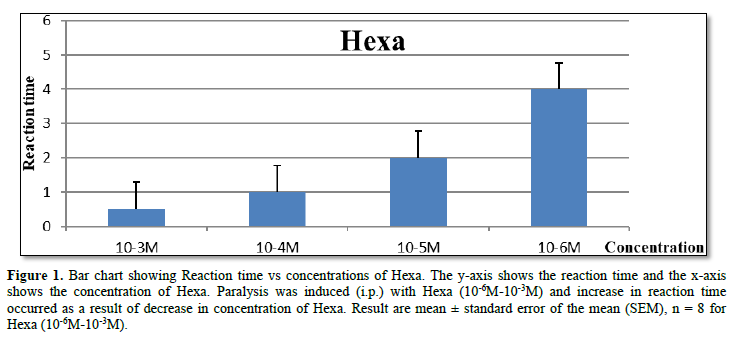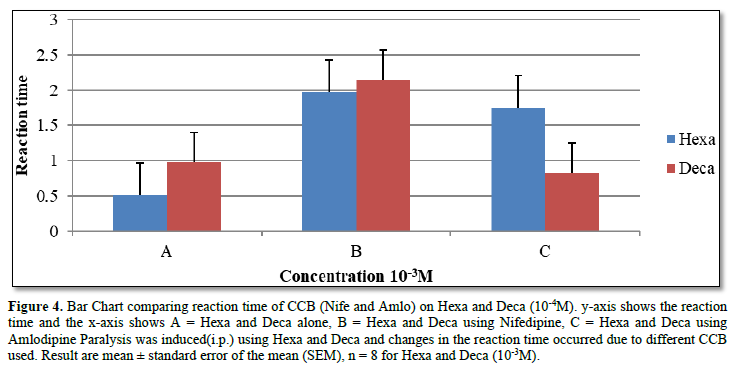969
Views & Citations10
Likes & Shares
The nervous system can exert excitatory control over contraction of muscles and it can as well have a blocking effect on reflex contractions and hyperreflexia. This control is ultimately achieved through the transfer of action potential from the nerve to the target muscle with the aid of a neurotransmitter in order to ascertain conversion of nerve impulse to appropriate muscle contraction of the skeletal, smooth, or cardiac muscle. Hence, due to intact NMJ and adequate neuromuscular transmission process, all the important functions that needs voluntary or involuntary contraction of skeletal, smooth, or cardiac muscles, such as circulation, respiration, digestion, urination, locomotion, etc., could be carried out efficiently [2].
The Neuromuscular blocking drugs inhibit neuromuscular transmission at the NMJ and this leads to the paralysis of affected muscles. This effect is achieved through their action on the post-synaptic acetylcholine receptors [3]. Neuromuscular blockers are commonly administered during anesthesia to enhance endotracheal intubation, improve surgical conditions and as well aid mechanical ventilation in patients with reduced lung compliance [4].
Paralysis is caused by structural abnormalities of nervous or muscular tissue or by metabolic disturbances in neuromuscular function. It happens when something goes wrong with the way messages pass between your brain and muscles [5]. It may be flaccid with loss of muscle tone, the muscles get flabby and shrink or spastic the muscles tighten (stiff), causing uncontrollable jerks and spasms [6].
MATERIALS AND METHODS
Animals
Animals used Mice (20g-25g ±0.5g (n=96) in this study were obtained from the Igbinedion University central animal house. The animals were fed on livestock feed (pellets) and kept under 12 h darkness and 12 h daylight and they had access to day light. Ethical Clearance IUO/ref 047/24.obtained.
Experimental Procedures
Preparation of Solution and Drug Dilution as Follows:
- From a stock solution of Hexamethonium 10mg/ml, the following concentrations were prepared by serial dilution (10-6M-10-3M).
- Similar procedure was carried for Decamethonium.
- From a stock solution of Nifedipine 2mg/ml and Amlodipine 1mg/ml, (10-3M) was prepared by serial dilution. The animals were divided into 4 groups (a,b,c, and d) containing 8 mice in each group.
- From a stock solution of 10mg/ml of Hexamethonium, a concentration of (10-6M-10-3M) was prepared by serial dilution. After that, 0.3ml of each concentration was administered (i.p.) to mice and the time of administration, reaction time and observations (spastic and flaccid paralysis) were recorded. Similarly, the same procedure was repeated using Deca.
- In this study, Mice were administered (Oral) 10-3M of Nifedipine and Amlodipine 1 h prior to the administration of Hexamethonium (10-3M and 10-4M).
Similarly, the same procedure was repeated using Deca.
NOTE: All drugs used in the studies were BDH products.
RESULTS AND OBSERVATION
- Dose Response relationship in this study is presented below (Table 1).

- In this study, the dose that sustained paralysis are indicated on the table below (Table 2).

- This result shows the effect of CCB on experimentally induced paralysis using Deca (10-3M and 10-4M) (Table 3).

Bar chart showing Reaction time of doses of Hexa (Figure 1).

 Bar chart comparing the reaction time RT for equimolar doses of Hexa and Deca (Figure 3).
Bar chart comparing the reaction time RT for equimolar doses of Hexa and Deca (Figure 3).Bar Chart comparing reaction time of CCB (Nife and Amlo) on Hexa and Deca (10-3M) (Figure 4).



DISCUSSION
In this study, the effect of Nifedipine and Amlodipine (10-3M) was examined on concentrations of Hexa (10-6M-10-3M) and Deca (10-6M-10-3M). The neuromuscular blocking activity of Hexa and Deca has been studied extensively.
Hexa is known to be a weak antagonist at the postsynaptic nicotinic acetycholine receptor but a potent antagonist at the pre-synaptic nicotinic receptor. From the result of the experiment above, it was indicated that the dose that elicit paralysis effect without causing death for Deca is (10-4M) while for Hexa is (10-3M) this shows that Decamethonium is more potent than Hexamethonium because Deca (10-3M) caused death of the animals.
Also, the time-dependent study on reactions in this experiment in which the results above indicated that paralysis was induced at (10-3M) for Deca in 0.98 min while in Hexa 0.51 min, at (10-4M), paralysis was induced using Deca in 1.68 min while in Hexa 1 min, at (10-5M) paralysis was induced using Deca in 3.71 min while in Hexa 2 min, at (10-6M) paralysis was induced using Deca in 12 min while in Hexa 4 min.
Furthermore, CCBs are drugs that inhibit the influx of Ca2+ by limiting the presence of this ion, thereby enhancing paralysis. Moreover, this study shows that after administration(oral) of the CCBs 1 h prior to inducing paralysis, Amlodipine exerted a significant potentiatory paralysis effect compared to Nifedipine due to shorter reaction time and duration of action obtained.
Using Deca (10-3M), the reaction time in the presence Nifedipine and Amlodipine was 2.15 min and 0.83 min respectively and death occurred. Here, the reaction time for amlodipine 0.83 min was shorter compared to the reaction time observed for paralysis induced using only Deca (10-3M) which was 0.98 min. Also, the duration of action of spastic paralysis observed in Deca (10-3M) only was 4.36 min and in the presence of Nifedipine and Amlodipine were 4.13 min and 3.58 min respectively. This shows that both CCBs potentiated the paralysis effect in mice due to shorter duration of action i.e. death occurred faster in mice.
However, using Hexa (10-3M) the reaction time in the presence of Nifedipine and amlodipine was 1.97 min and 1.75 min respectively and no death occurred. Here, a significant potentiatory effect was not observed compared to the reaction time obtained in paralysis induced using only Hexa (10-3M) which was 0.51 min.
2. Jimsheleishvili S, Marwaha K, Sherman AL. Physiology, Neuromuscular Transmission. In: Statpearls[Internet]. Treasure Island (FL): Statpearls publishing; 2024 Jan. Available online at: https://www.ncbi.nlm.nih.gov/books/NBK541133/
3. Appiah-Ankam J, Hunter JM (2004) Pharmacology of neuromuscular blocking drugs. Contin Educ Anaesth Critical Care Pain 4(1): 2-7.
4. Cook D, Simons DJ (2023) Neuromuscular Blockade. In: Statpearls [Internet]. Treasure Island (FL): Statpearls publishing; 2024 Jan. Available online at: https://www.ncbi.nlm.nih.gov/books/NBK538301/
Britannica, T. Editors of Encyclopaedia (2024) Paralysis. Encyclopedia Britannica. Available online at: https://www.britannica.com/science/paralysis
Aziba PI, Idumange TR, Senjobi CT, Akee MA, Oluwasegun A (2022) Studies on the Actions of Calcium Channel Blockers, Anticholinesterases Agents on Experimentally Induced Spastic Paralysis in Normotensive Rats. Biosci Biotech Res Asia 19(2): 365-371.








